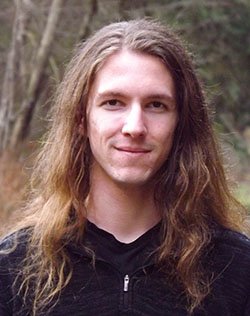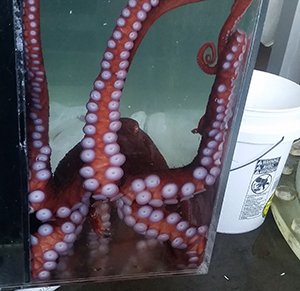Across the Evolutionary Divide: the Story of Gaia
 |
| Dominic Sivitilli |
Dominic Sivitilli (Behavioral Neuroscience student with David Gire) spent the summer in Friday Harbor Laboratories in the San Juan Islands studying Enteroctopus dofleini, the giant Pacific octopus. Check out his account of his experience here.
Vertebrates make up but a small minority of the diversity that evolution has made of the ancestral nervous system. If we truly mean to understand cognition, we need to broaden our perspective across the diversity of these forms—we need to look beyond the vertebrate model to other worlds of thought entirely. For this reason, I have chosen the octopus as my model organism.
I laid the groundwork for studying cognition in this new model by consolidating a paradigm to deconstruct and characterize the behavior of Octopus rubescens, the Pacific red octopus, the smaller of the two species local to the Puget Sound (at an adult arm span of around 30 cm). After a year, I was ready to turn my sights on Friday Harbor Laboratories in the San Juan Islands, and to the other species, Enteroctopus dofleini, commonly known as the giant Pacific octopus, the largest species of octopus known.
I spent weeks diving the dark, green depths that wove between the San Juan Islands; on the edge of black, watery gulfs I searched for a long lost cousin. 45 feet below San Juan County Park, my dive team at last methodically encircled a large, camouflaged, breathing mass, as it watched us intently.
Like a fission reaction, word spread of our new lab resident. Before I could catch my breath, a wave of curious and confused descended on Lab 2.
 |
Nightfall and finally alone in a quiet, dim lab, I felt my movements being watched. I sat facing my new model, observing her as she continued to fix her gaze upon me. About five feet separated the tips of her opposite arms when she reached them outward—she was young, yet, she seemed so old, reaching out to me from deep evolutionary time.
Unlike the highly centralized nervous system of the vertebrates, that of the octopus exists mostly in their eight flexible arms. Here, in each arm, the nervous system takes the form of a chain of neural clusters, or ganglia, running in parallel to the octopus’ suckers, with each ganglion processing the input from the tens of thousands of sensory receptors from the adjacent sucker. By outsourcing a large degree of motor and sensory processing into localized semi-autonomous neural pathways within these chains, the octopus can process this massive amount of sensory information in parallel while relieving the brain of much of the necessary computational burden to respond accordingly.
When an arm is removed or its connection to the brain severed, it will move freely, respond to touch and recoil from noxious stimuli. This autonomous behavior suggests that the arms are inhibited when attached to the brain, and by selectively removing inhibition of certain peripheral neural pathways, the brain allows the arms to execute behaviors while the other pathways within the arms remain silenced. The large degree of information from the suckers is then consulted to adjust the automated motor response to the immediate and acute representation of the world.
This being before me took a different path entirely to a wholly foreign mind, a journey that began when we parted more than 500 million years ago: two simple-minded cousins setting out to wander aimlessly a long, turbulent road toward cognitive complexity. I named her Gaia.
As I prepared her next tank for her arrival, Gaia was visited regularly by lab residents and visitors alike. Although obviously too small for comfort, her temporary tank allowed the opportunity for visitors to easily interact with her. To the unnerving realization of the uninitiated, even the most gentle contact with her suckers was enough to elicit her arm to ensnare and eagerly coil around idle hands. The more one was to resist, the more eager the arm was to entangle its newly found play-thing, while each sucker searched intently for a relevant stimulus to communicate to the brain.
 |
She was placed in her new, larger tank and set out immediately to explore its boundaries. Typically, studies of animal behavior employ an ethogram, an exhaustive list of an animal’s behavior. Instead, an automated approach allows me to catalogue not just the behavioral profiles of the entire animal, but that of each arm simultaneously. By then characterizing correlations in movement pattern and symmetry between arms as a function of the sensory information available to the octopus, I can begin to model the flow of information in this system that allows the octopus to coordinate its highly autonomous arms in response to controlled exposure to various environmental conditions, revealing the computational strategies they are employing to coordinate the highly independent divisions of their nervous system. Before, I could only accomplish this with the Pacific red octopus fitting comfortably in a 50 gallon tank. Friday Harbor Labs allowed me to work at a different scale entirely.
Gaia continued to attract the attention of the multitude of residents and visitors during the summer terms of the labs, while I and the occasional team of volunteers, to whom I owe an incredible debt of gratitude, provided enrichment, cleaning service, and a daily sacrificial crab.
After many came to visit her one last time, we returned Gaia to her home below San Juan County Park six weeks after we found her. I then bid farewell to the labs, and the wonderful and welcoming community that I called home for the summer of 2017.
Perceptive, curious, and above all, distant, Gaia manifested everything to me that makes the octopus model so attractive. Two cousins we are, meeting across the evolutionary divide of over 500 million years.